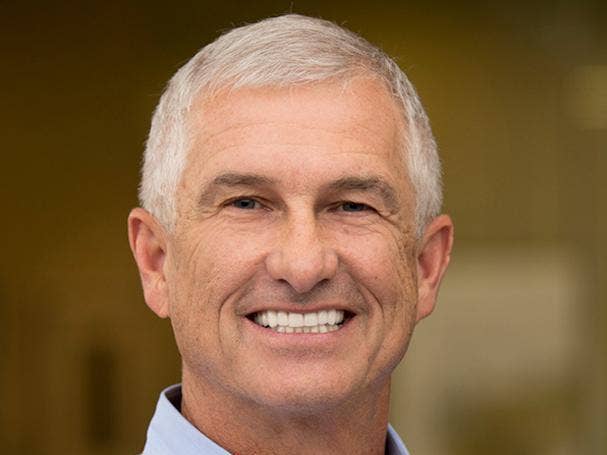ScanSource CEO Mike Baur: ‘This Technology Refresh Is Still In The Early Innings’
‘ We believe that enterprises are going to make long-term decisions about how to accommodate their remote workers and their hybrid workforce, as well as all the companies that are now providing multi- and omni-channel experiences. … And, frankly, the demand has been staggering for us,’ ScanSource CEO Mike Baur tells CRN.

‘We Built The Leading Hybrid Distributor’
ScanSource, a global distributor with a focus on point-of-sale, mobility and payment technologies, Tuesday reported a strong first fiscal quarter, which ended Sept. 30. Sales were up compared with last year by over 13 percent to $857.3 million, and GAAP net income was $22.1 million, or 86 cents per share, compared with a loss last year.
ScanSource CEO Mike Baur described the quarter as “fantastic,” telling CRN that his company has become the leading hybrid distributor, which he defined as one that sells not just hardware but hardware that is part of a solution that also includes software and services. “Hardware plus software, hardware plus any kind of recurring product,” he said. “Really, it’s that hardware-plus story that I think we’ve got uniquely in the markets we compete in.“”
Greenville, S.C.-based ScanSource is looking to ride a wave of change as the channel quickly adopts a recurring revenue focus. Here is what Baur had to say about how ScanSource is helping propel that change.

How would you describe the quarter?
I think the quarter was fantastic. [Our team of] sales and supplier professionals just ... allowed us to take market share in a very competitive business, as you know. It allows us to take market share because we have such a strong organization that understands how to win.
How has that competitive situation changed with the merger of Tech Data and Synnex into TD Synnex or the acquisition of Ingram Micro by Platinum Equity?
We are really a clear leader in hybrid distribution. And we really believe when you look at the companies that we compete directly against, it’s really not those companies. There are a lot of other companies that are in spaces that are part of what we do, but really there’s no direct peer competitor for ScanSource today. So what we have to do is make sure we understand what our customers need. And I think our success this quarter and frankly all of last year indicates that we built the leading hybrid distributor in the business.
Can you define ‘hybrid distributor?’
I’m glad you asked. We have been trying to describe better why we win. And when we looked at the last five years, from our acquisitions and our structure, it became clear to us that the Intelisys acquisition really was the first phase of being able to offer what we’re calling a ‘hybrid solution,’ which for us means ‘hardware plus.’ Hardware plus services, which was what we were doing even before the Intelisys acquisition, but even more so now—hardware plus software, hardware plus any kind of recurring product. Really, it’s that hardware-plus story that I think we’ve got uniquely in the markets we compete in.

So how did the economic environment play a part in the quarterly results for ScanSource?
What we believe has been happening, frankly, since the pandemic—which has now gone on almost a year and a half—is that companies that put in early solutions for a remote workforce are now finding out that they need to do a technology refresh. And in this technology refresh, and it’s across the whole IT industry, but in our areas of specialization we’re seeing tremendous growth because the companies have the economic capability to invest in their technology refresh because they’re all seeing strong demand, whether it’s retail or the back side of retail, which is warehousing and distribution. All of those companies are seeing strong demand, and they’re trying to figure out how do they answer the demand with more automation. And that requires them to invest in new technology. And so this technology refresh cycle, I think, is the largest one I’ve seen in years.
And what part of that technology refresh cycle has the biggest impact on ScanSource's operations?
There are a couple of areas we’ve been talking about. One is this whole idea of mobility where companies have to have their workers engage with customers in different places. Stores are the easiest example. Restaurants are another one. Whether it’s stores doing self-checkout or mobile checkout throughout the store, or in the case of restaurants where they’re doing curbside or deliveries, all of those delivery companies use technology. So I think anytime you see examples like that, those are in our sweet spot. And obviously anything that connects devices to the cloud, that’s where we win.

Do you see this continuing into the future or is this something that might slow down a little bit as the pandemic hopefully starts to become less of a factor?
Well, I think this technology refresh is still in the early innings. We believe that enterprises are going to make long-term decisions about how to accommodate their remote workers and their hybrid workforce, as well as all the companies that are now providing multi- and omni-channel experiences. I think all of those suggest this is a long-term investment cycle for companies. And, frankly, the demand has been staggering for us. The challenge we still hear from everybody is, ‘Can you get it for me now? I need the product. I need to satisfy my customer.’ And our teams have done a fantastic job managing through supply chain issues better than our competitors. We think a strategic ScanSource advantage is our willingness to keep more inventory than our competitors and take share.
Can you give me an example of what you mean by keeping more inventory than your competitors do?
Our inventory turns are about six to seven, and that by the way compares to any other distributor that is going to be in the double digits, 10, 12, 14 times. So we’re turning inventory always, as a company, much slower because we’ve realized that you can’t sell solutions unless you have the entire product, all the pieces to the solution. And so we’ve been doing that for years. And I think we have an advantage of managing solution-selling because with our business model we’re comfortable keeping a higher level of inventory. And so those six or seven turns of inventory, they’re the same today as they were a year ago. The difference is, with the six to seven turns of inventory, we have the right inventory, and that’s allowing us to take market share.
As a percentage of ScanSource's revenue, what is hardware now? And how has that been changing?
Well, it’s something that we don’t break out directly. I can’t give you a number. But what you’ll see and what we‘ve talked about is, we’re seeing the recurring revenue part of our business, the non-hardware, growing faster traditionally than our hardware. Now this quarter, we actually had really strong hardware growth, but we’re seeing the recurring revenue, whether it’s software or services, growing faster than our traditional hardware business. And that’s our strategy. We think users are changing the way they buy, and how they consume it. Sometimes that means they’re not buying hardware, they’re renting hardware, leasing hardware, subscribing to software. All of those consumption changes are changing the dynamics of how we sell. And we believe we’ve got the right consumption models for the customer.

Starting this quarter, ScanSource is reporting its business with new operating segments. The former worldwide barcode, networking and security segment is now the specialty technology solutions segment, and the former worldwide communication services segment is now modern communications and cloud. What’s behind the name changes?
Well, we had a couple of things going on. One of the things [was] one of our suppliers has transitioned over the last few years from being a strong hardware company that fit in our barcode segment into much more of a services and software and recurring revenue communications company. So one of our larger suppliers has transitioned their business to fit our communications business. And that’s the way we sell it and go to market. [Furthermore], in the past, the only real services or recurring revenue we talked about was Intelisys. And we want to make it clear to our investors that we have recurring revenue opportunities in both segments. The business that was formally known as worldwide barcode is now specialty. That’s a hardware-plus story, just like our modern communications is a hardware-plus story. So we think it better shows the alignment between our focus on recurring revenue. And then lastly, these two segments better reflect how we go to market. These two segments differ in their profile of who the customer is, who the channel partner is, and this is how [our] team is organized. So it better reflects our go-to-market strategy.
What is the difference between the two in terms of target customers and go-to-market?
If you look at the communications segment, it’s the move to recurring revenue. And so there’s much more focus on that go-to-market strategy on how to sell subscriptions and why customers want to buy it that way. And our telecom business moved quicker to be a cloud and subscription-type business more so than our barcode business. That’s now part of specialty technology where we’re seeing customers need hardware like barcoding and they want to pick up software and services too. So we’re still early days where the amount of recurring revenue we have in that new segment called specialty technology.
Will the renaming of the segments result in any operational changes at the ScanSource?
No. I think today it really reflects the way we’re already operating. We made this decision earlier this year.